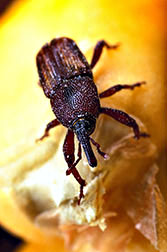Science Update
Soybean Enzyme Replacing Formaldehyde
An enzyme from soybean hulls is now replacing formaldehyde in adhesives, abrasives, protective coatings, and other products. In the early 1980's, ARS scientists were first to purity the enzyme, a soybean peroxidase, and scrutinize its properties. That work led to five industry patents. The enzyme assists the reactivity of oxygen and peroxides with many compounds. The marketed uses range from medical diagnostic tests to removal of chlorine-containing pollutants from high-temperature industrial wastewater. Soybean peroxidase is more easily isolated than peroxidase from horseradish, now a major source.
David J. Sessa, USDA-ARS National Center for Agricultural Utilization Research, Peoria, Illinois; phone (309) 681-6351.
Kit To Detect Coccidiosis Drug
Under a cooperative research and development agreement (CRADA), ARS and Neogen Corp, of Lansing, Michigan, are developing a commercial kit to detect presence of a medication, salinomycin, in poultry feed and broiler chicken meat. Salinomycin is added to broiler feed to protect the birds from coccidiosis. Caused by a protozoan, the disease costs U.S. poultry producers about $450 million a year in drugs and production losses. The kit will use monoclonal antibodies to check whether salinomycin has been properly mixed into feeds and whether residues linger in tissues of slaughtered chickens. Salinomycin is not a synthetic chemical, but is prepared from fermentations of natural micro-organisms.
USDA-ARS Food and Feed Safety Research Unit, College Station, Texas
 Maize weevil (K3980-17) |
ARS Taps Grain Bugs' Suppertime
Through another CRADA, ARS and a Maryland firm wilt improve an ARS system that estimates whether—and how many—insects infest a sample of grain. The system, ALFID (for Acoustic Location Fixing Insect Detector), captures and analyses sounds of insects feeding on grain. But the sensors often detect only the loudest—that is, the largest—insects. So scientists want to incorporate a technique developed by Defense Research Technologies, Inc., of Rockville, Maryland. It uses compressed air to amplify sound waves. This would allow ALFID to pick up the fainter munching of tiny larvae inside grain kernels.
Dennis Shuman, USDA-ARS Mosquito and Fly Research Unit, Gainesville, Florida; phone (352) 374-5737.
Gene Probe Unmasks Culprit in Soybean Sudden Death
DNA probes devised by ARS scientists quickly reveal the fungal villain blamed for Sudden Death Syndrome (SDS) in soybean Fields. Diagnosis takes under 24 hours, compared with up to 4 weeks for standard methods. SDS affects soybeans in about a dozen states. The probes are based on computerized genetic data from all species of Fusarium fungi including the SDS pathogen.
Kerry O'Donnell, USDA-ARS National Center for Agricultural Utilization Research, Peoria, Illinois; phone (309) 681-6383.
Nature's Chemical Factory Yields a Kiwifruit Protector
A helpful fungus—or its fragrant extract—kept nearly all of 6,000 refrigerated New Zealand kiwi safe from mold for a year, with no flavor or quality loss. Botrytis cinerea mold damaged half the untreated fruit. Scientists with ARS and the Horticulture and Food Research Institute of New Zealand, Ltd., conducted the less. The approach could also benefit marketers of U.S. kiwi and find broader use as an alternative to chemical fungicides used against molds of strawberries and other stored fruits. The good fungus is Trichoderma harzanium.
An ARS scientist isolated the extract and discovered its anti-mold properties. The extract—known as 6-PAP, or 6-pentyl-alpha-pyrone—has an aroma resembling a blend of coconut and celery. Peaches also make 6-PAP—it's found in natural peach essence—and a synthetic version is used in some foods and perfumes. The technology may be commercialized in a couple of years if it passes further tests, including a current one using 26,000 kiwis. ARS and the New Zealand institute are seeking joint patent protection.
USDA-ARS Richard B. Russell Agricultural Research Center, Athens, Georgia.
"Science Update" was published in the January 1996 issue of Agricultural Research magazine.






